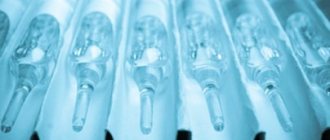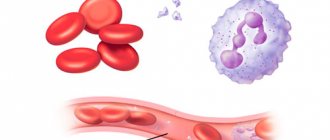Chemotherapy is a very effective method of fighting cancer. Despite the fact that doctors try to select those chemotherapy drugs that mainly affect malignant cells, healthy ones are also affected.
As a result, the patient’s hair falls out, immunity deteriorates, digestive problems begin, and the balance of the composition in the blood is greatly disturbed. The speed of recovery and the duration of rehabilitation depend on the doctor, the patient and the chosen treatment.
Normal blood composition
As a result of exposure to chemicals, the patient may develop anemia and leukopenia, as well as other complications. This is due to a strong impact on the hematopoietic system and bone marrow. The ESR, or erythrocyte sedimentation rate, also increases greatly due to the decreased number of red blood cells.
Norm
| Blood cells | Normal indicator | |
| In men | Among women | |
| Red blood cells | 4.0-5.0 x 109/l | 3.5-4.7 x 10¹²/l |
| Hemoglobin | 130-170 g/l | 120-150 g/l |
| Platelets | 180-320 x 109/l | |
| Leukocytes | 4.0-9.0 x 109/l | |
Signs of reduced levels
The doctor concludes that platelet levels are decreasing based on a blood test. During the treatment they are done several times, which allows you to track the number of blood cells responsible for blood clotting. Normally, in a healthy person their number is 180-320 x 109/l.
The following symptoms may indicate that there has been a decrease in the number of blood cells:
- bruises and hematomas appear on the skin for no apparent reason, which do not go away for a long time;
- Gums constantly bleed;
- the nose often bleeds;
- it is impossible to stop the oozing blood for a long time even from a small wound;
- bloody stools and blood in the urine appear;
- Women experience prolonged, heavy menstruation.
The appearance of even one sign may indicate that the composition of the blood has changed for the worse, and it is necessary to take measures to increase platelet levels.
Important information: What do low eosinophils in an adult indicate in a blood test?
After chemotherapy
The course of chemotherapy lasts quite a long time. Usually a complex of several drugs is prescribed, both in tablet form and by injection. After a certain period, the doctor will prescribe a biochemical and general blood test to look at the changes and how critical they are.
- Platelets are responsible for the process of blood clotting. A large decrease in the number of clots leads to thrombocytopenia. As a result, even a small wound can lead to heavy bleeding. Bruises and spots appear on the skin, and blood constantly oozes from the gums. There is a danger of internal bleeding. Bleeding may appear in the stomach, uterus, etc. If platelets drop sharply, doctors may prescribe a transfusion.
- Leukocytes - the number of these cells is greatly reduced, immunity deteriorates, which is why the patient is susceptible to almost all diseases. First of all, doctors are trying to increase this indicator. The temperature rises, redness and inflammation, diarrhea, rash, and sore throat appear on any wounds.
- Red blood cells - erythrocytopenia appears, the cells do not receive the required amount of oxygen, the patient feels tired, drowsiness and weakness appear throughout the body.
- Hemoglobin is an important substance in oxygen exchange between red blood cells and body tissues. After chemotherapy, this indicator drops significantly and anemia occurs.
The task of the patient and doctors is to quickly and with minimal losses restore blood cells to balance.
How to quickly increase platelets in the blood after chemotherapy: what foods can increase platelets
Chemotherapy is an effective procedure in the fight against cancer. Therapy uses chemicals aimed at destroying cancer cells. However, healthy tissues are also affected.
As a result, cancer and subsequent procedures cause baldness, decreased immune defense, and a disorder in the blood composition.
The chosen treatment method greatly influences the duration of the recovery period and the speed of recovery.
Symptoms of thrombocytopenia
Thrombocytopenia increases the risk of life-threatening symptoms for the patient. Symptoms are more pronounced if the level of platelets is reduced, more than three times the standard. The norm is 180-320 x 109/l for men and women. A sudden and noticeable decrease in components in the blood is characterized by the indicator:
- gum bleeding for a long time;
- blood oozes systematically and intensely from the nose;
- increase in the duration of menstruation in women;
- increased size of the spleen;
- sudden formation of bruises;
- the appearance of petechiae - small red dots on the epidermis;
- there are feces with bloody manifestations, urine with blood clots;
- pain in the muscular and joint systems;
- cough and vomiting with blood;
- secretion of blood in hemorrhoidal areas;
- bleeding in the stomach and intestines.
The patient is not always notified of the development of thrombocytopenia while taking potent drugs. At the initial stage, the problem does not show symptoms.
Due to the chemotherapy procedure, platelets and white blood cells drop, increasing the likelihood of developing diseases. Complications lead to a poor prognosis. The outcome in such cases is often fatal.
Knowledge of methods for increasing hemoglobin in the blood if platelet volumes have fallen will help the patient prevent an unpleasant list of consequences.
Medicinal medicines
If platelet counts are low, the problem is identified during a blood test. When chemotherapy is completed, patients are prescribed a course of certain medications. Thanks to their consumption, the number of megakaryocytes increases. The main therapeutic agents in the fight against pathology are:
- Dicynone is a chemotherapy drug widely used among drugs aimed at protecting against thrombocytopenia. The component promotes the formation of platelets in the bone marrow and increases the rate of their elimination. The chemical composition of the drug is known for its ability to strengthen and maintain capillary walls. Thanks to the systematic use of the product, blood clotting improves.
- Sodium deoxyribonucleate is an element extracted from fish of the sturgeon family. The medicine helps restore the body, strengthens the immune system and quickly stabilizes the process of platelet formation. The elements are administered intramuscularly using injections.
- Glucocorticosteroids are aimed at combating severe thrombocytopenia. Prednisolone and Dexamethasone are particularly effective. The drugs act as analogues of hormonal cells growing in the adrenal cortex. When using such substances, it is recommended to adhere to the exact dosage.
- Vikasol is prescribed for complex therapy and as a preventative measure for bleeding. The component helps reduce symptoms.
- Thrombopoietin – has increased effectiveness. The drug increases platelet production in the liver.
- Aminocaproic acid is prescribed as a solution. The component is taken after meals.
A lot of methods have been developed to treat thrombocytopenia. However, the basis of any therapy after chemotherapy is the comprehensive prevention of bleeding. If an inflammatory process has developed in the body, a course of antibiotics is prescribed.
With thrombocytopenia the level should be higher. Taking medications is permissible after the doctor’s permission.
It is highly not recommended to self-medicate, so as not to harm yourself further! For auxiliary measures, the patient is administered cyanocobalamin or folic acid.
Traditional medicine and diet
Treatment with folk remedies will suggest methods of increasing the number of platelets during chemotherapy. Alcohol-free herbal infusions and decoctions promote rapid recovery and healing. Therapy is possible according to prescriptions that have a beneficial effect on the patient’s health.
Selected methods will help raise platelets after chemotherapy:
- To make a healthy decoction you will need chamomile flowers, shepherd's purse and mint leaves. The components must be mixed together according to the ratio 1:2:2. The resulting mixture is poured with 1/4 liter of water, then put on fire. Cook for 15 minutes after boiling. Before use, cool the broth and drink 100 ml in 2 approaches per day to increase platelets.
- Nettle is a source of many beneficial elements. The plant will also help increase platelets in the blood. For therapy, take freshly squeezed nettle juice or make a decoction based on dried nettle leaves.
- Fragrant tea from a collection of herbs will add significant benefits to the body. The drink can be made from the following herbs: rose hips, yarrow, verbena, strawberry fruits and leaves. The folk piggy bank also includes sesame and linseed oils.
Medicinal herbs that increase low blood cell volumes have shown excellent effective properties. The following will help raise platelets in the blood after chemotherapy:
- nettle;
- Rowan;
- Sesame oil;
- chamomile;
- peppermint;
- shepherd's purse;
- verbena;
- kidney knotweed;
- beet;
- Oak bark;
- yarrow;
- strawberries;
- rose hip.
Before using herbal remedies, it is recommended to consult with your doctor for contraindications and possible complications.
Proper nutrition
To enhance the healing properties of folk remedies, it is necessary to maintain a balanced diet. The therapy method will enhance the recovery of the body as a whole.
It is important to fill your diet with foods with the required amount of microelements, fats, proteins, carbohydrates and minerals. It is beneficial to eat fresh fruits and vegetables every day.
When hemoglobin is low, foods increase the level of blood cells and fill the body with sufficient amounts of vitamin C and iron. Important microcomponents are contained in:
- pumpkin;
- carrots;
- beets;
- red vegetables and fruits;
- honey;
- propolis;
- chicories;
- cereals;
- berry compotes.
Experts recommend adding more nuts to your diet: almonds, walnuts and pine nuts, as well as red caviar and legumes. Don't forget about the variety of greens.
A diet with the addition of healthy plants to the dishes consumed is recommended. Among the types of spices, coriander, cloves and saffron are acceptable.
It is important to avoid drinking alcohol-containing liquids, which negatively affect the development of red bone marrow.
To increase the level of safety and protection of the mucous tissues of the oral cavity and gastrointestinal organs, careful processing and grinding of consumed products is required, which reduces the risk of complications. It is necessary to avoid rough and hard products to prevent internal bleeding.
General recommendations
Often, after completion of chemotherapy for cancer, an independent process of tissue restoration, especially platelets, is possible. However, it will take a long time for the cells to fully recover. Regarding long-term adverse reactions, including changes in blood structure, the consequences of the procedure persist in patients until the end of their lives.
Patients experiencing thrombocytopenia are advised to follow these rules:
- It is important to avoid injury to the body; even small cuts are dangerous.
- Before the onset of menstruation, women will have to take medications that inhibit the onset of the next menstrual cycle.
- To enhance the protective functions of the gastric mucosa, it is recommended to take Omeprazole and similar drugs.
- Among toothbrushes, experts advise choosing models with soft bristles.
- At home, it is recommended to provide the patient with a soft environment; surrounding objects should be made of soft materials.
- It is especially important to carefully clear your sinuses. To do this, it is recommended to blow them lightly, without harsh impacts, in order to avoid damaging the integrity of the tissues.
- When shaving, it is recommended to give preference to electric razors.
- Taking aspirin and anticoagulants is prohibited.
- It is important to avoid the use of medicinal products containing acetylsalicylic acid.
- You should refrain from physical exercises that have an increased risk of injury.
- You should not leave the house during icy conditions.
- It is prohibited to consume alcoholic beverages and medications without first consulting a doctor.
If you get cuts, you need to apply a pressure bandage and use a special sponge to stop the bleeding. To stop nosebleeds, you can use Naphthyzin. Compliance with the above recommendations will help restore platelet volume in children and adults.
Platelet recovery
How to quickly increase platelets in the blood after chemotherapy? Doctors prescribe a number of drugs:
- Etamsylate or dicinone.
- Corticosteroids: rednisolone, dexamethasone.
- Interleukin medications – 9.
- Derinat or Sodium deoxyribonucleate is a natural medicine made from sturgeon fish using milk extract.
- Prednisolone.
- A complex of vitamins with an emphasis on B and C.
- Dexamethasone.
- Microelements - calcium, magnesium, zinc, lysine, etc.
The doctor constantly monitors platelet levels on the coagulogram, both after chemotherapy and during treatment and during the recovery process.
Diet
To raise platelets after chemotherapy, you should focus on nuts, fruits, dried fruits, sprouted soybean sprouts, and seeds. Among the folk methods, tinctures from chaga, nettle, and yarrow are well suited. But you can take them only after the approval of your doctor.
| Nutrition | Description |
| Proteins, fish and seafood | The most important thing is to restore the amount of protein, zinc and vitamin B12. To do this, eat more chicken, turkey, crabs, and beef. Try to eat lean meat and fish. |
| Greenery | For women it is better to consume up to 90 mcg of greens, and for men 120 mcg. You need to eat more green vegetables with vitamin K - dill, onions, parsley, cucumbers, zucchini. An excellent addition would be the drug warfarin. |
| Folic acid | Also called vitamin B9, it is necessary for hematopoietic cells of any type. There is a lot of it in: beans, peas, lentils, oranges, spinach. |
| Dairy | Eat fermented milk products containing calcium, cottage cheese, cheese, homemade yogurt, broccoli, figs, and turnips are also suitable. For the absorption of calcium, magnesium is necessary, which is abundant in any greenery. |
Try to eat more plant foods and less animal foods to reduce the internal acidic environment and make it alkaline. This will make it more difficult for metastases to develop again and they can be destroyed. Avoid alcohol, smoking, fatty meats, sweet, spicy, highly salted foods, foods containing dyes and flavor enhancers.
Reduce the risk of bleeding
- Do not shave with a regular razor, preferably an electric one. If this is not possible, then give up this activity altogether.
- When brushing your teeth, try not to press too hard on the brush so as not to injure your gums. Choose and buy a brush with soft bristles.
- Avoid blowing your nose too hard to avoid causing nosebleeds.
- Be careful not to injure yourself or cut yourself. Internal hematomas are also dangerous.
Nettle tincture
You can also increase platelets with a folk remedy. The most important thing is to collect the natural medicine at the end of August, when it has the strongest juice.
- Take a small amount of nettle and grind it in a blender.
- 50 ml. mix with 5 ml. nettle juice.
- 3 times a day 30 minutes before meals.
Diagnosis and treatment of thrombocytopenia
Diagnosis of the disease
Thrombocytopenia is one of the easily diagnosed diseases with pronounced symptoms. To establish a final diagnosis, a detailed examination of the medical history, a general blood test, tests for the body’s immunological response, and a bone marrow puncture will be required.
The treatment regimen for the disease is largely determined by the stage of its development. For initial and moderate severity, home therapy may be indicated. All patients with blood cell levels below 20,000 are subject to hospitalization. This condition is considered life-threatening and requires treatment under the constant supervision of medical staff.
To increase the level of platelets in the blood and increase its coagulability, the following medications are prescribed in tablets and injection solutions:
- Methyluracil, which improves trophism in tissues and helps accelerate regeneration processes;
- Prednisolone, which prevents the destruction of blood cells in the spleen and increases the strength of capillaries;
- Sodecor, which can increase platelet levels in the shortest possible time;
- Dicynone (Etamsylate), which is effective in treating bleeding, increasing thrombus formation at sites of injury;
- Hydrocortisone, which affects the synthesis of proteins and enzymes;
- Dexamethasone, which actively stimulates the formation of blood cells.
Drug doses are determined individually and depend on the severity of thrombocytopenia. If long-term use of such drugs is necessary, regular blood tests for a coagulogram are indicated.
The following treatment methods are used as additional measures:
- transfusion therapy (transfusion of platelets or donor blood),
- splenectomy (removal of the spleen as a site of destruction of blood cells);
- bone marrow transplant.
For additional support of the body, it is recommended to take vitamins B and C complexes, the minerals magnesium, calcium, zinc, and lysine.
To relieve symptoms of thrombocytopenia, tableted drugs Vikasol, Ascorutin, antiseptic biological suppositories, Naphthyzin drops are used.
Taking pills is aimed at stopping bleeding and strengthening the walls of blood vessels. Suppositories are effective for hemorrhoidal bleeding, have an antiseptic effect and help relieve pain. Nasal drops cause constriction of nasal vessels in case of bloody discharge.
Hemoglobin restoration
To quickly increase hemoglobin, doctors use drugs. Basically, the complex contains vitamin B12, iron, folic acid, etc.
NOTE! If the level is less than 80 g/l, the doctor prescribes a transfusion of red blood cells. If you have money, you can order the drugs Eprox and Neorecomon.
Useful to use:
- Apples.
- Carrot.
- Walnuts.
- Cranberry juice.
- Beetroot juice.
- Pomegranate.
- Raisins and dried apricots.
- Radish.
- Turnip.
- Figs
- Cabbage.
- Lemon.
What does it mean if there are few platelets in the blood?
When the level of platelets in the blood decreases, the formation of the primary platelet clot (thrombus) is disrupted. Since the process of hemostasis starts sequentially, disruption of its first link leads to disruption of all subsequent links of hemostasis.
A bleeding disorder in a patient is manifested by an increased tendency to bleed. Clinically this manifests itself:
- prolongation of bleeding time from small and large wounds;
- the appearance of gingival, nasal, etc. bleeding;
- lengthening the time of menstrual bleeding and increasing its abundance;
- the appearance of hemorrhagic rashes;
- slight appearance of bruises (hematomas) on the skin, etc.
Red blood cell recovery
In general, with proper nutrition and therapy, as well as a positive attitude of the patient, the red blood cells are restored quite quickly, normal health appears, and many normoblasts appear in the blood.
If the rate drops significantly below 70 g/l, a transfusion of red blood cells may be prescribed. The most important thing is to follow the diet and the doctor’s advice. The danger of a long-term decrease in red blood cells is that the patient may develop Alzheimer's disease.
( 3 ratings, average: 4.67 out of 5)










